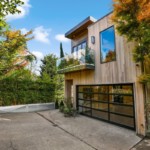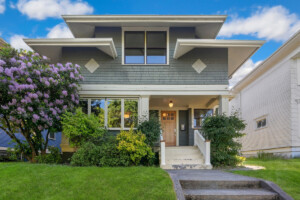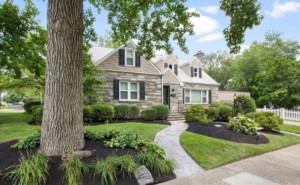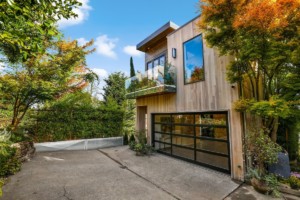
When it comes to looking at houses and deciding which house is right for you, it is critical to think about the functional design of a house. In the realm of house design there is arguably no more influential element than the roof line. The roof line defines the look of a house more than any other attribute, and the shape of the roof line will determine how the roof protects the house from rain, wind, sun and snow.
A common question I get during my home inspections is whether flat roofs are less desirable than sloped roofs. I love this question because it gets at the logic that can be employed to see how a given house design will predict required maintenance.
Are There Really Flat Roofs?
To begin, I’d like to clear up a commonly misused word to describe a flat roof. You should never really encounter a truly flat roof. All roofs should be sloped to drain. Water weighs more than eight pounds per gallon and you never want to turn your roof into a swimming pool; roofs are generally not framed to support significant ponding water. So, it would be more accurate to consider a sloped roof V.S. a low slope roof. I used flat roof in the title because I felt this was common usage.
How to Measure a Roof Slope
The standard way to measure a roof’s pitch is by its fall over 12 inches. A roof that falls one inch over 12 inches is called a 1 and 12 and would be considered low slope.
- Low slope roofs are generally pitches of 3 and 12 or less.
- Sloped roofs are generally 4 and 12 and greater.
Low Slope Roofs: The Roofing Type
Low slope roofs need to have a membrane system as a roof covering. Membranes are generally sheets of roofing material installed in such a way that the roof would not leak if standing water were present. There are a multitude of different membrane systems: torch-down, single-ply and built-up being the most common. You cannot use shingles on roofs with pitches less than 3 and 12 and even a 3 and 12 requires special installation techniques to prevent leaks and failure.
Low Slope Roofs: As Good as the Installation
Low slope roofs have a well-earned reputation for being troublesome. Because they don’t shed water well they’re more likely to have leaks, and leaks on flat roofs can be a real pain to track down; you can find yourself chasing water, which is never fun and can make roof replacement the only sure-fire option for repair. Combined with comparatively more expensive installation cost and shorter useful service life, low slope roofs are generally higher maintenance roofs than sloped roofs. However…
Like all roofing systems, a lot depends on the quality of the installation. Some of the newer single ply membranes are coming with 50-year warranties. It is unclear if they will perform reliably for this long, but they seem to be a superior product to some of the older membrane systems if installed well. Many older membrane systems, like torch down, often have about 10 years of life without much care and then another 5-15 years where ongoing patching and repairs are needed.
The Advantage of Low Slope – Good Overhangs and Good Light
The one real advantage to a low slope roof is if the building also comes with large roof overhangs (where the plane of the roof hangs out past the walls of the house.) Some houses have low slope roofs with large overhangs and because the roof is low slope, the roof overhangs do not block your windows. This design affords good protection of the house and nice interior light. While you do have a generally higher-maintenance low slope roof, this should come with lower maintenance siding, windows, doors and decks as they are protected by the roof. This can be a great trade off. Contrast this with a pitched roof house that does not have the benefit of a roof overhang. Such a house may have the benefit of a sloped roof, but the increased maintenance costs for the exposed siding, trim, windows, doors and decks could far exceed the additional maintenance costs of a low slope roof. The bottom line: roof overhangs are your friend when it comes to reducing exterior maintenance.
The Advantage of a Pitched Roof
Pitched roofs are generally less expensive to install and last longer than low slope roofs. This is because shingle systems are easier to install than membrane systems and shingles cost less. This is a generalization that depends a great deal on the type of roofing material you install, but is a good guiding principal. My personal favorite pitch for a roof is a 5 and 12; this pitch sheds water well but is not too steep – you can still have good roof overhangs to protect the building and the roof is just shallow enough in pitch that you can walk on the roof to service it. Roofs steeper than 5 and 12 are difficult to walk on.
Watch Out for Complex Roof Lines
A great guiding principal when looking at roof lines and maintenance is that complex roof lines are more likely to be a problem than simple roof lines. A complex flat roof may have lots of things stored on it like HVAC systems and duct work. It might have lots of penetrations like skylights and vents or intersecting roof plains like roof-to-wall junctures. Sloped roofs could have a myriad of intersecting planes, roof to wall junctures, deck intersections or valleys draining at the sides of the house. Be wary of complex roof lines whether sloped or low slope. Bottom line: When it comes to low maintenance roof lines, simplicity is your friend.
One of my favorite low-maintenance roof designs is the shed roof. This is just a single tilted plane of a roof and even if it is low slope, the design is usually so simple that problems are less likely.
In Conclusion
You would be wise to consider the relative benefits and drawbacks of various roof lines as you look at houses to buy. Do not underestimate the value of a good roof line. If low exterior maintenance is what you are looking for, seek homes with generous roof overhangs and simple roof lines.



























 United States
United States Canada
Canada